This is an excerpt from “E(race)ing Inequities: The State of Racial Equity in North Carolina Public Schools” by the Center for Racial Equity in Education (CREED). Go here to read the full report and to find all content related to the report, including the companion report Deep Rooted.
Gifted and talented programs like North Carolina’s Academically or Intellectually Gifted (AIG) are intended to serve students with higher abilities. The AIG program challenges students in regular classroom settings and provides enrichment and an accelerated curriculum. Research has found that gifted and talented programming can positively influence students’ postsecondary plans, future advanced degree attainment, and the likelihood of noteworthy professional accomplishments. Programs like AIG are also part of schools’ attempts to address stakeholder concerns about whether advanced students are being adequately challenged in general education classes. They are also designed to calm concerns that the pressures of helping struggling students combined with a lack of training in gifted education may constrain teachers’ ability to address the needs of gifted students. Studies have documented inequitable access to gifted programs for Black and Hispanic students along with disparities based on gender, language status, and special education status (U.S. Department of Education, 2016a; U.S. Department of Education, 2016b).
In North Carolina, students can be designated AIG in math, reading, and/or other and can hold multiple designations. The AIG Other designation means students have been evaluated and selected as intellectually or academically gifted in ways that fall outside the traditional math or reading designations. State legislation [N.C.G.S. § 115C-150.5-.8 (Article 9B) Academically or Intellectually Gifted Students] mandates that local educational agencies (LEAs) identify and serve academically or intellectually gifted (AIG) K-12 students.1 Each LEA determines how to identify and serve its own AIG student population. LEAs must adhere to state legislation as well as the NC AIG Program Standards, which act as a statewide framework and the official guidelines for the development of local AIG plans. LEAs also submit AIG plans to the Department of Instruction annually for review and comment.
What oversight exists beyond review of AIG plans is unclear. While the NC AIG Program Standards do not position racial equity in AIG as an explicit goal, they do affirm that: “[o]utstanding abilities are present in students from all cultural groups…” and charge LEAs with ensuring that “AIG screening, referral, and identification procedures respond to under-represented populations of the gifted…” (NC State Board of Education, 2018, p. 1, 2).
Given the potential benefits of AIG programs on attainment and future professional outcomes, we position AIG as an indicator of access to rigorous and advanced curricula. Specifically, we view differential exposure to advanced curricula, such as those envisioned for AIG students, based on race/ethnicity as a potential constraint on the educational attainment and life chances for under-represented populations.
Methodology
We examined racial/ethnic differences in the proportion of students across all grade levels and each of the three AIG designations. We also built prediction models to assess the likelihood that a student would be designated AIG based on race/ethnicity while controlling for gender, language status, free/reduced lunch eligibility, and special education status. This allowed us to isolate the effect of race/ethnicity on AIG designation to the greatest extent possible with the available data.
Statewide in 2016-2017, approximately 3.9% (~45,000 students) were designated AIG Math, 2.9% (~34,000 students) were designated AIG reading, and 0.2% (~3000 students) were designated AIG Other.
Analysis
AIG Math
Approximately 45,000 students were classified as AIG Math in 2016-2017. Figure 4.1 shows the proportion of AIG Math students by race/ethnicity.
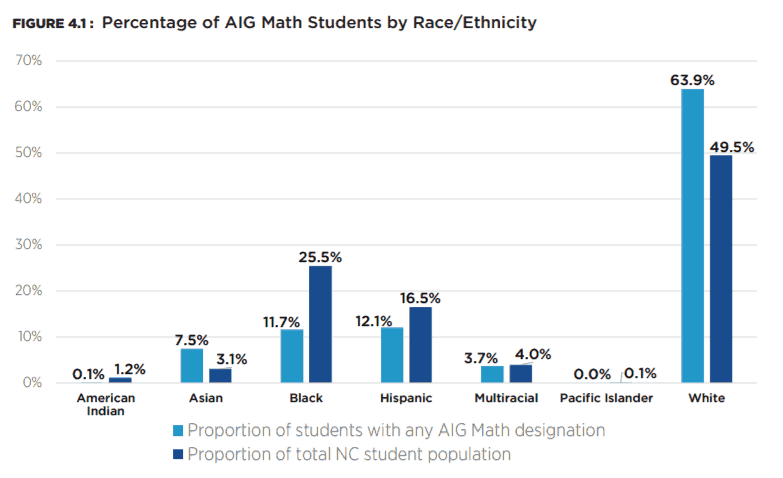
Asian and White students are over-represented in AIG Math, and American Indian, Black, Hispanic, Multiracial, and Pacific Islanders are under-represented. American Indian and Black students have the highest degree of under-representation. The number of American Indian students designated AIG Math is less than one-tenth of what we would expect given their share of the overall state student population. If Black students were selected for AIG Math in proportion to their share of the student population, over 6200 additional Black students would be classified AIG Math.
We also built prediction models to further parse the effect of race/ethnicity on giftedness in math. Using White students as a comparison group, we predicted the likelihood that students from different racial/ethnic groups would be designated AIG Math while controlling for gender, free/reduced lunch eligibility, language status, and special education status. The results are presented in Figure 4.2. Model 1 shows the effect of race/ethnicity alone on the likelihood of an AIG Math designation. Model 2 shows the effect of race/ethnicity while controlling for other factors.
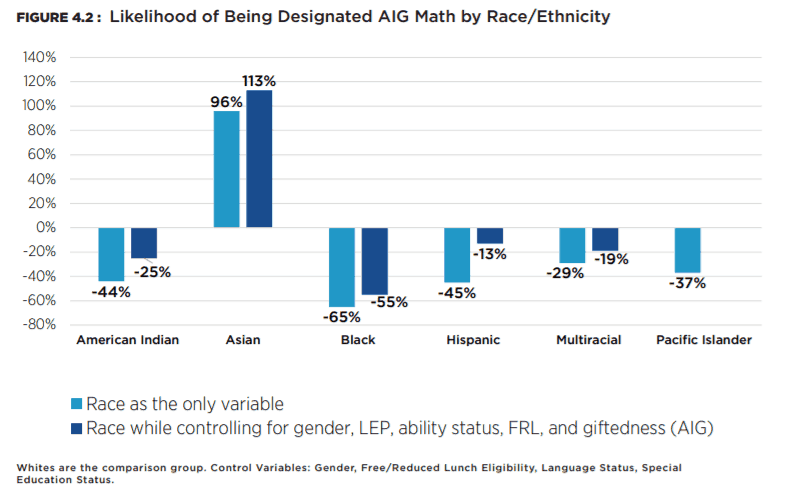
Race/ethnicity remains a significant and substantial predictor after controlling for other predictors in the model. Asians are designated AIG Math at more than double the rate of their White counterparts. American Indian, Black, Hispanic, and Multiracial students are under-selected for AIG Math after controlling other factors. Net of other factors, the magnitude of under-selection for Black students (as compared to Whites) is more than double that of any other group.
AIG Reading
Approximately 34,000 students were classified as AIG Reading in 2016-2017. Figure 4.3 shows the percentage of AIG Reading students by race/ethnicity.
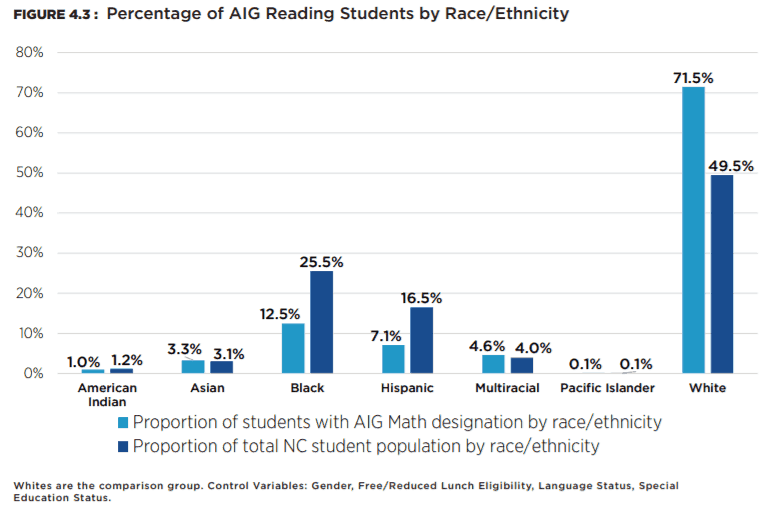
Asian, White, and Multiracial students are over-represented among those designated AIG Reading as compared to their percentage of the overall state student population. American Indian, Black, and Hispanic are under-represented. The proportion of AIG Reading students that are Black and Hispanic is less than half of what we would expect based on their proportion of the total North Carolina student population. As was the case with AIG Math, the number of American Indian students designated AIG Reading is less than one-tenth of what we would expect given their share of the overall state student population.
If the proportion of Black students designated AIG Reading was the same as their proportion of the overall student population, over 4300 additional Black students would be designated AIG Reading.
We also built prediction models to further parse the effect of race/ethnicity on giftedness in reading.
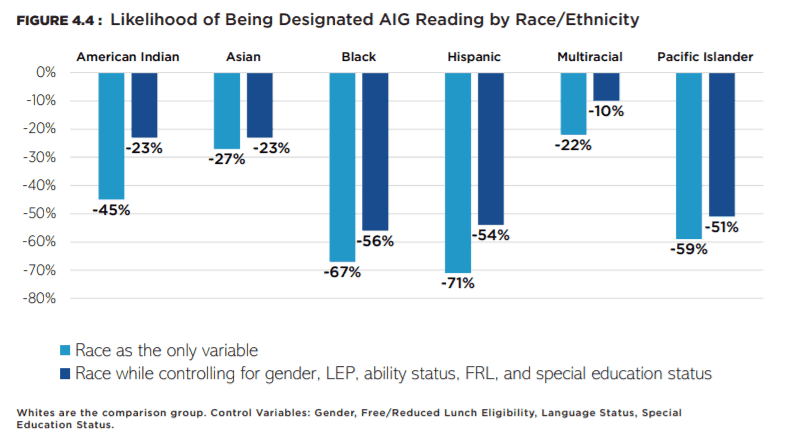
Race/ethnicity remains a significant and substantial predictor after controlling for other predictors. All student groups of color are under-selected for AIG Reading in comparison to their White counterparts. Black, Hispanic, and Pacific Islander students were less than half as likely to be considered gifted in reading in comparison to Whites.
AIG Other
The AIG Other designation means students have been evaluated and selected by their LEA as intellectually or academically gifted in ways that fall outside the traditional math or reading designations. Figure 4.5 shows the proportion of students designated AIG Other by race/ethnicity.
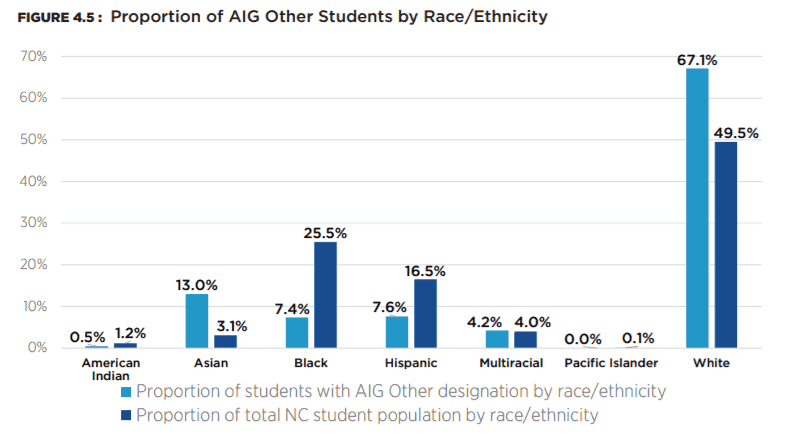
Asian, White, and Multiracial students are over-represented among those designated AIG Other as compared to their proportion of the overall state student population. American Indian, Black, Hispanic, and Pacific Islanders are under-represented. The proportion of AIG Other students that are American Indian, Black, and Hispanic is less than half of what we would expect based on their proportion of the total NC student population. The number of Black students designated AIG Other would more than triple if they were proportionally represented among those designated AIG Other.
The result of the prediction model for AIG Other follows the same pattern as those for Math and Reading as shown in Figure 4.6.
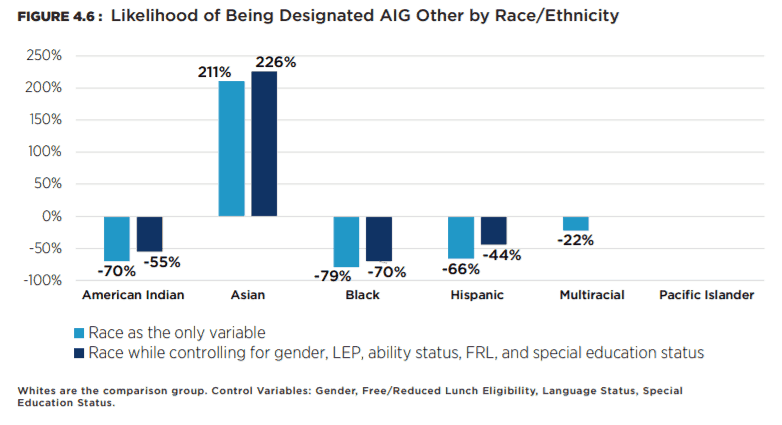
As in the previous models for Math and Reading, race/ethnicity remained a significant predictor of AIG Other after controlling for other factors, with the exception of Multiracial and Pacific Islander students. The likelihood of Asian students being designated AIG Other was dramatically higher than their White counterparts after controlling for other factors while American Indian, Black, and Hispanic students were less likely to be designated AIG Other net of other factors.
AIG Any
Figure 4.7 shows the proportion of students with any AIG designation by race/ethnicity. Students may have a single (i.e. AIG Math) or multiple designations (any combination of AIG Math, AIG Reading, AIG Other).
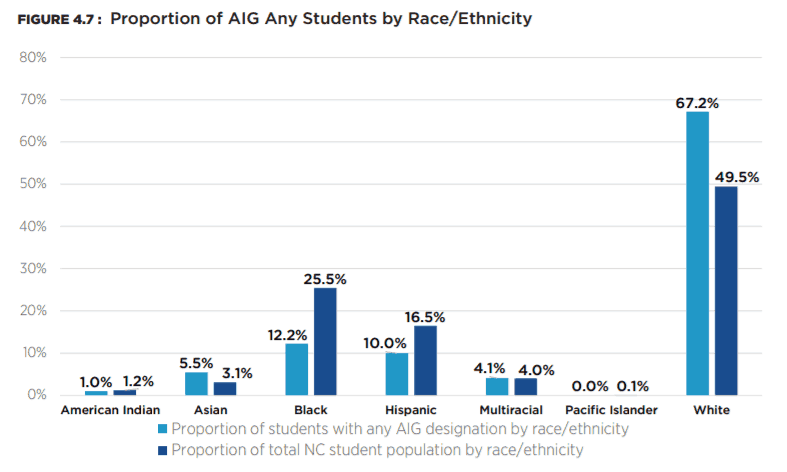
Asian, White, and Multiracial students are over-represented among those designated AIG Any as compared to their proportion of the overall state student population. American Indian, Black, Hispanic, and Pacific Islanders are under-represented. The proportion of AIG Any students that are Black is less than half of what we would expect based on their proportion of the total NC student population. Hispanics also have a large disparity. Were Black students proportionally represented in AIG Any almost 10,000 additional Black students would benefit from an AIG designation.
The result of the prediction model for AIG Any follows a now familiar pattern. Figure 4.8 presents the predicted results.
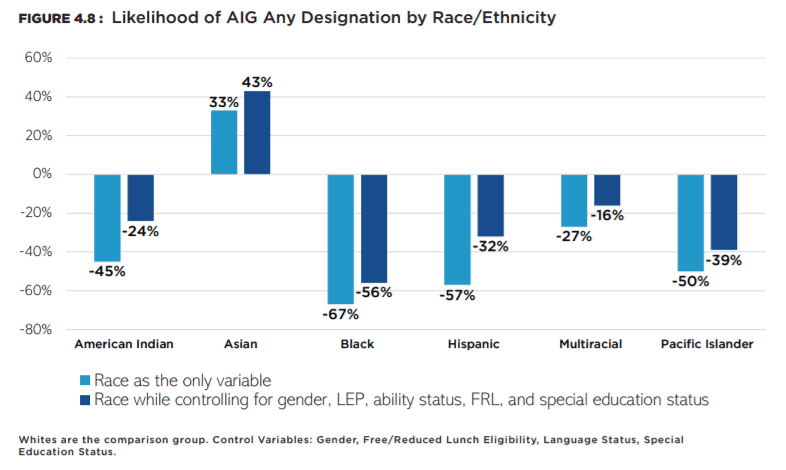
Race/ethnicity remained a significant predictor of AIG Any for all student groups of color as compared to their White counterparts after controlling for other factors. The likelihood of Asian students being designated AIG Any was substantially higher than their White counterparts after controlling for other factors while all other student groups of color were less likely to be designated AIG Any net of other factors.
Takeaways
There are clear patterns of racial disparity across all three AIG designations. In both AIG Math and AIG Other, Asian and White students are over-represented in comparison to their percentage of the state student population. American Indian, Black, and Hispanic students are under-represented in both AIG Math and AIG Other. In AIG Reading, Asian, White, and Multiracial students are over-represented, and all other groups are under-represented in comparison to their proportion of the total state student population. The degree of negative disparity for American Indian and Black students holds across all AIG designations. Furthermore, race/ethnicity is a significant and substantial predictor of differential AIG designations net of all other relevant factors.
The under-exposure of student groups of color in gifted and talented programs has the potential to diminish their long-term educational attainment, postsecondary participation, and professional achievements.
References
Hertberg-Davis, H. L., & Callahan, C. M. (2013). Introduction. In H. L. Hertberg-Davis & C. M. Callahan (Eds.),Fundamentals of gifted education (pp. 1–10). New York, NY: Routledge.
Kell, H. J., Lubinski, D., & Benbow, C. P. (2013). Who rises to the top? Early indicators. Psychological Science, 24, 648–659.
Loveless, T., Farkas, S., & Duffett, A. (2008). High-achieving students in the era of NCLB. Washington, DC: Thomas B. Fordham Institute.
Lubinski, D., Webb, R. M., Morelock, M. J., & Benbow, C. P. (2001). Top 1 in 10,000: A 10 year follow-up of the profoundly gifted. Journal of Applied Psychology, 4, 718–729.
North Carolina State Board of Education. Department of Public Instruction. (2018, June). North Carolina academically or intellectually gifted program standards: State board of education policy ACIG-000. Raleigh, NC: NC Department of Public Instruction. Retrieved Mar 31, 2019 from http://www.ncpublicschools.org/docs/advancedlearning/aig/ncaig-program-standards.pdf
Park, G., Lubinski, D., & Benbow, C. P. (2007) Contrasting intellectual patterns predict creativity in the arts and sciences: Tracking intellectually precocious youth over 25 years. Psychological Science, 18, 948–995.
U.S. Department of Education. (2016). Persistent Disparities Found Through Comprehensive Civil Rights Survey Underscore Need for Continued Focus on Equity, King Says. Retrieved Feb 18, 2019 from: https://www.ed.gov/news/press-releases/persistent-disparities-found-through-comprehensive-civil-rights-survey-underscore-need-continued-focus-equity-king-says
U.S. Department of Education. Office of Civil Rights. (2016). A first look key data highlights on equity and opportunity gaps in our nation’s public schools. Washington D.C., U.S. Department of Education Office for Civil Rights.
Editor’s note: James Ford is on contract with the N.C. Center for Public Policy Research from 2017-2020 while he leads this statewide study of equity in our schools. Center staff is supporting Ford’s leadership of the study, conducted an independent verification of the data, and edited the reports.





